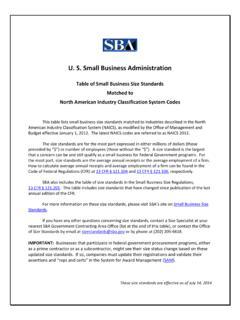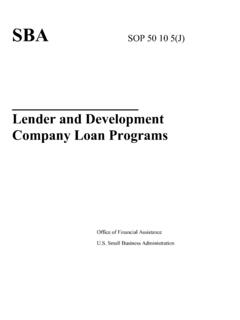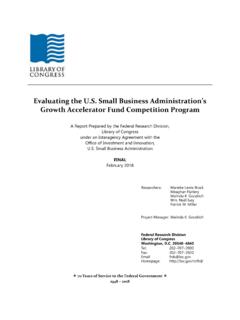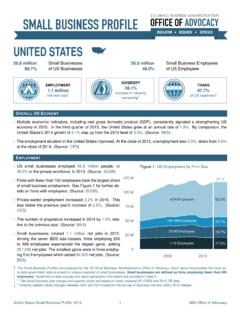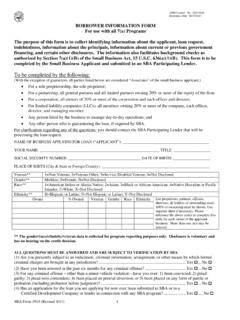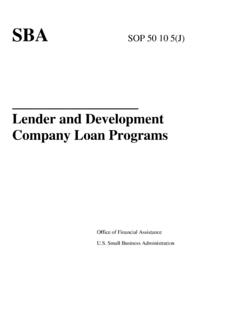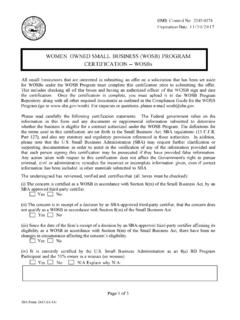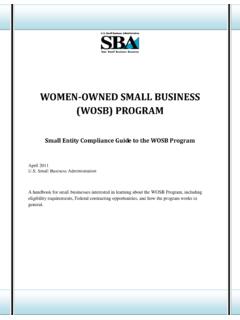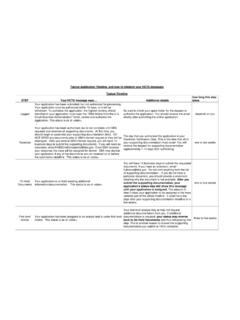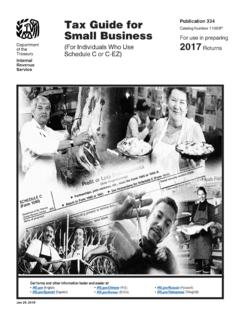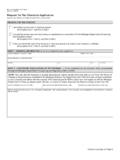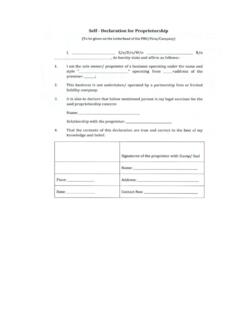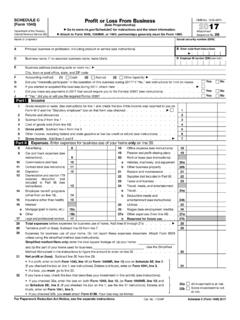Transcription of PPP: How to Calculate Maximum Loan Amounts for First …
1 As of March 12, 2021 PAYCHECK PROTECTION PROGRAM HOW TO Calculate Maximum loan Amounts FOR First DRAW PPP LOANS AND WHAT DOCUMENTATION TO PROVIDE BY BUSINESS TYPE The Small Business Administration (SBA), in consultation with the Department of the Treasury, is providing this updated guidance to assist businesses in calculating their payroll costs (and the relevant documentation that is required to support each set of calculations) for purposes of determining the Maximum amount of a First Draw Paycheck Protection Program (PPP) loan for each type of business. Borrowers and lenders may rely on the guidance provided in this document as SBA s interpretation of the CARES Act, the Economic Aid Act, and of the Paycheck Protection Program Interim Final Rules.
2 The government will not challenge lender PPP actions that conform to this guidance1 and to the PPP Interim Final Rules and any subsequent rulemaking in effect at the time the action is taken. The guidance describes payroll costs using calendar year 2019 as the reference period for payroll costs used to Calculate loan Amounts . However, borrowers are permitted to use payroll costs from either calendar year 2019 or calendar year 2020 for their First Draw PPP loan amount Documentation, including IRS forms, must be supplied for the selected reference period. 1. Question: I am self-employed and have no employees, how do I Calculate my Maximum First Draw PPP loan amount if I use net profit? (Note that PPP loan forgiveness Amounts will depend, in part, on the total amount spent by the borrower during the covered period following disbursement of the PPP loan .)
3 Answer: The following methodology should be used to Calculate the Maximum amount that can be borrowed if you are self-employed and have no employees, and your principal place of residence is in the United States, including if you are an independent contractor or operate a sole proprietorship , and you use net profit (but not if you are a partner in a partnership): Step 1: Find your 2019 IRS Form 1040 Schedule C line 31 net profit If this amount is over $100,000, reduce it to $100,000. If this amount is zero or less, you are not eligible for a PPP loan . Step 2: Calculate the average monthly net profit amount (divide the amount from Step 1 by 12). 1 This document does not carry the force and effect of law independent of the statutes and regulations on which it is based.
4 2 All components of payroll costs must be from the same calendar year. Payroll costs, including for covered benefits, can only be included for employees whose principal place of residence is in the United States. 3 If you are using 2020 Amounts and have not yet completed a 2020 return, fill out the required portions and compute the values. As of March 12, 2021 Step 3: Multiply the average monthly net profit amount from Step 2 by Step 4: Add the outstanding amount of any Economic Injury Disaster loan (EIDL) made between January 31, 2020 and April 3, 2020 that you seek to refinance. Do not include the amount of any advance under an EIDL COVID-19 loan (because it does not have to be repaid).
5 Your 2019 IRS Form 1040 Schedule C must be provided to substantiate the applied-for PPP loan amount. You must also provide a 2019 IRS Form 1099-MISC detailing nonemployee compensation received (box 7), IRS Form 1099-K, invoice, bank statement, or book of record establishing you were self-employed in 2019 and a 2020 invoice, bank statement, or book of record establishing you were in operation on February 15, 2020. 2. Question: I am self-employed and have employees, how do I Calculate my Maximum First Draw PPP loan amount (up to $10 million) if I use net profit? (Note that PPP loan forgiveness Amounts will depend, in part, on the total amount spent by the borrower during the covered period following disbursement of the PPP loan .)
6 Answer: The following methodology should be used to Calculate the Maximum amount that can be borrowed if you are self-employed with employees, including if you are an independent contractor or operate a sole proprietorship and use net profit (but not if you are a partner in a partnership): Step 1: Compute your 2019 payroll costs by adding the following: o 2019 IRS Form 1040 Schedule C line 31 net profit amount:4 if this amount is over $100,000, reduce it to $100,000, if this amount is less than zero, set this amount at zero; o 2019 gross wages and tips paid to your employees whose principal place of residence is in the United States, up to $100,000 per employee, which can be computed using: 2019 IRS Form 941 Taxable Medicare wages & tips (line 5c-column 1) from each quarter, Plus any pre-tax employee contributions for health insurance or other fringe benefits excluded from Taxable Medicare wages & tips, and Minus (i) any amount paid to any individual employee in excess of $100,000, and (ii) any Amounts paid to any employee whose principal place of residence is outside the United States.
7 O 2019 employer contributions for employee group health, life, disability, vision, and dental insurance (the portion of IRS Form 1040 Schedule C 4 If you are using 2020 payroll costs and have not yet completed a 2020 return, fill it out and compute the value. As of March 12, 2021 line 14 attributable to those contributions); o 2019 employer contributions to employee retirement plans (IRS Form 1040 Schedule C line 19); and o 2019 employer state and local taxes assessed on employee compensation, primarily state unemployment insurance tax (from state quarterly wage reporting forms). Step 2: Calculate the average monthly payroll costs amount (divide the amount from Step 1 by 12). Step 3: Multiply the average monthly payroll costs amount from Step 2 by Step 4: Add the outstanding amount of any EIDL made between January 31, 2020 and April 3, 2020 that you seek to refinance.
8 Do not include the amount of any advance under an EIDL COVID-19 loan (because it does not have to be repaid). Your 2019 IRS Form 1040 Schedule C, IRS Form 941 and state quarterly wage unemployment insurance tax reporting form from each quarter (or equivalent payroll processor records or IRS Wage and Tax Statements), along with documentation of any retirement or group health, life, disability, vision, and dental contributions, must be provided to substantiate the applied-for PPP loan amount. A payroll statement or similar documentation from the pay period that covered February 15, 2020 must be provided to establish you were in operation and had employees on that date. 3. Question: I am a self-employed farmer or rancher who reports my income on IRS Form 1040 Schedule F.
9 What documentation must I provide in place of Schedule C and how should my Maximum loan amount be determined (up to $10 million)? Answer: Self-e mployed farmers and ranchers ( , those who report their net farm profit on IRS Form 1040 Schedule 1 and Schedule F) should use IRS Form 1040 Schedule F in lieu of Schedule C. The calculation for self-employed farmers and ranchers without employees is the same as for Schedule C filers that have no employees, except that Schedule F line 9 (gross income) should be used to determine the loan amount rather than Schedule C line 31 (net profit). The calculation for self-employed farmers and ranchers with employees is the same as for Schedule C filers that have employees with several exceptions.
10 First , in place of Schedule C line 31 (net profit), the difference between Schedule F line 9 (gross income) and the sum of Schedule F lines 15, 22, and 23 (for employee payroll) should be used. Second, employer contributions for employee group health, life, disability, vision and dental insurance (portion of Schedule F line 15 attributable to those contributions) and employer contributions for employee retirement contributions (Schedule F line 23) should be used in place of those respective lines on Schedule C. As of March 12, 2021 The documentation requirements are the same as for Schedule C filers except the 2019 IRS Form 1040 Schedule 1 and Schedule F must be included with the loan application in place of IRS Form 1040 Schedule C.
